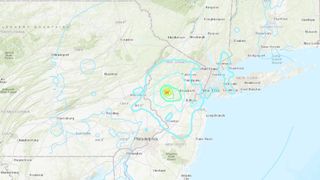

Earthquakes are the result of plate tectonics, or shifting plates in the crust of Earth, and quakes occur when the frictional stress of gliding plate boundaries builds and causes failure at a fault line. In an earthquake, elastic strain energy is released and waves radiate, shaking the ground. Scientists can predict where major temblors might occur in a general sense, but research does not yet allow forecasts for specific locations or accurate predictions of timing. Major earthquakes, some generating tsunamis, have leveled entire cities and affected whole countries. Relatively minor earthquakes can also be induced, or caused by human activity, including extraction of minerals from Earth and the collapse of large buildings.

By Rebecca Owen, Eos.org published 26 July 24
Researchers found the 2023 Morocco earthquake was triggered by movement miles below Earth's surface.

By Stephanie Pappas published 12 July 24
A new simulation of the shaking from a magnitude 7.8 south San Andreas earthquake suggests that Los Angeles might avoid a worst-case scenario.

By Katherine Irving published 9 July 24
Changes in sea level and glacial melt could make earthquakes more likely in the coming years.

By Sascha Pare published 18 June 24
A new study suggests an earthquake of estimated magnitude 7.5 or 8 shook the Indian subcontinent 2,500 years ago, changing the course of the Ganges.
 strewn across the floor in the aftermath of an earthquake." width="" />
strewn across the floor in the aftermath of an earthquake." width="" />
By Alice Sun published 13 May 24
It's well known that earthquakes can rock fault-filled places like the U.S. West Coast. But why do earthquakes happen in the middle of tectonic plates?

By Stephanie Pappas published 10 May 24
An odd earthquake swarm has struck the region between the Czech Republic and Germany, far from any tectonic plate boundary.
 A sign posted at the San Andreas Fault, separating the Pacific and the North American tectonic plates near Parkfield, California on July 12, 2019 in a remote part of California." width="" />
A sign posted at the San Andreas Fault, separating the Pacific and the North American tectonic plates near Parkfield, California on July 12, 2019 in a remote part of California." width="" />
By Stephanie Pappas published 9 April 24
The Parkfield section of the San Andreas fault is sending mixed messages before a time of expected increased seismic risk.

By Laura Geggel last updated 5 April 24
Magnitude 4.8 and 3.8 earthquakes struck New Jersey and rocked the Northeast on Friday (April 5).

By Ben Turner published 3 April 24
The earthquake, which struck on Wednesday morning, has killed nine people, injured more than 900 and left dozens trapped in underground tunnels.

By Stephanie Pappas published 21 March 24
Record earthquake activity off the coast of Vancouver Island hints at the birth of new oceanic crust.